I am crazy about the Australian bush landscape. And when I go to another country I’m also crazy about their rural and ‘bush’ landscape. Of course they don’t call it bush, it is forest. In Japan this forest is mountainous and beautiful. We came across cypress pines and bamboo and ancient places where temples were. Japan chooses to have up to 70% of its land forested, and although much would be difficult to build on it is largely a choice.
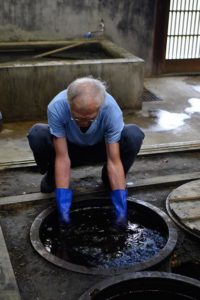
It is into and within this landscape that we visited two incredible and internationally acclaimed textile masters.The first was at Miyama. A more picturesque village I have never seen. Here the atelier and Indigo Museum of Hiroyuki Shindo is nestled in houses made from tall, textured and moss covered thatch. Some have described Mr Shindo as one of the most seminal textile artists of today. He is utterly dedicated to his craft and bridges and unifies the past and present with his work. We were very fortunate indeed to have the artist himself explain his processes. He continues to invent new ways of creating shibori cloth in indigo and his inventions are creative tools for preparing long lengths of cloth for the indigo dyebath vats.The floor of the indigo studio was once a farmhouse kitchen now devoted to the ceramic vats. To introduce fermentation he mixes composted leaves with lye, wheat bran, slaked lime and sake.It is a unpredictable process which he manages through long experience.
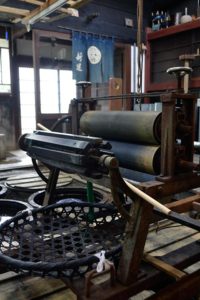
The end product left over from the bath is always natural and can be returned to the earth with no residue or issue at all. This is an important aim of his work as this type of dyeing requires patience and skill and isn’t focused on big production. It treads lightly, requiring work and sensitivity, but delivers great beauty.
The next artist was Jun Tomita. Co-author of Japanese Ikat Weaving and a master of contemporary kasuri. Very much a favourite artist of mine! He also lived in an amazing landscape with a studio converted from a glasshouse to provide good light nestled in a bamboo and Cypress forest.
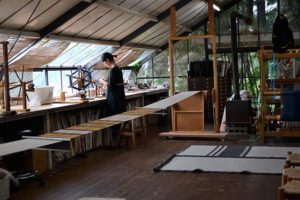
Nature propels the imagination and energy for creative work, in my humble option. And this studio was filled with that ideal. Commission work and kasuri/ikat work in progress was everywhere. Tomita’s wife Mayo Horinouchi, is also a weaver and artist and was weaving double cloth on a loom when we got there.
Jun Tomita spent some time at the Jam Factory in Adelaide early in his career (1976-78) and also studied at West Surrey College of Art and Design in the UK and worked with Peter Collingwood. Today he continues to weave commissioned wool rugs and I see his work in wool with an influence of that period.
These were important visits for me and the guests on the tour. Japanese textile artist studios like these are set up in ways that are much closer to how we work in Australia. The looms can be similar and the set up reflects our tools but importantly, build on that to show us how to work well with finer yarns and dye processes. They also hold traditions for storing and transferring warps which isn’t as well known in the general British and European traditions.
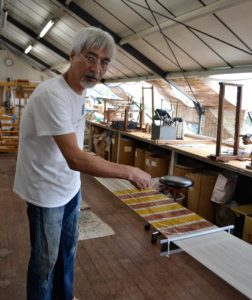
The other most enduring memory of these artists is their enormous generosity. Yes these visits were negotiated and arranged in a business way but still they were completely open with the way we viewed the studios and permission for photographs. They were both unassuming, modest men who, despite their artistic fame, lived very simply and purposefully with their dedication to the meaning of their work. At least this is my outsider view. I think this was about the point where I wanted to go home to my looms with utter inspiration!
The heart, as a theme this year in our donations to the East Timor Heart Fund, is such a tender and telling human organ. As a weaver, Japan and these experiences just make my heart sing somehow.
I am inviting expressions of interest for another Textile Tour of Japan in mid October 2017. I will be hosting the tour and Intentionally Different organise it.

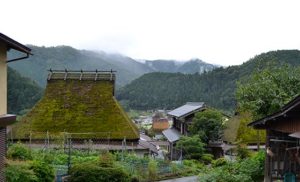
Leave a Reply